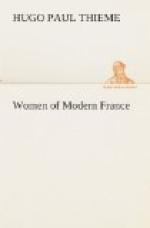Many salons which were all more or less patterned after that of Rambouillet sprang into existence. Among these the Academy of the Vicomtesse d’Auchy, with Malherbe as president and tyrant, was of little influence as far as women were concerned. The members were all of second-rate importance, and Malherbe tolerated only the discussion of his verses, while Mme. d’Auchy was better known for her splendid neck than for any intellectuality. Every salon had a master of ceremonies, who performed the rite of presentation; these men were frequently abbes, and some of them, such as Du Buisson and Testu, became famous.
Among the most noted of these salons was that of the celebrated beauty, Ninon de Lenclos, she who called the precieuses the “Jansenists of love,” an expression which became very popular. Her salon was situated on the Rue des Tournelles. Ninon de Lenclos was a woman of the most brilliant mind and exquisite taste, and it was at her hotel that Moliere first read his Tartuffe before Conde, La Fontaine, Boileau, Lulli, Racine, and Chapelle, and it was there that he received the principal ideas for his drama.
Ninon became famous for making staunch friends of her former lovers, in which connection some interesting tales are told. She was the mother of two children; upon the arrival of the first, a heated discussion arose between Count d’Estrees and Abbe d’Effiat, both claiming the honor of paternity. When the mother was consulted, she made no attempt to conceal her amusement; finally, the rivals threw dice for “father or not father.”
The other child, whose father was the Marquis de Gersay, was the victim of an unnatural passion for his mother with whom, when a young man, he fell desperately in love, being ignorant of their relation. While pleading his cause, he learned from her lips the secret, and, in despair, blew out his brains, a tragedy which apparently had no effect upon the mother. At one time, at the request of the clergy Ninon was sent, for impiety, to the convent of the Benedictines at Lagny.
Among her friends she counted the greatest men and women of the day and her salon was the foyer of savoir-vivre, of letters and art. At the age of sixty she met the Great Conde, who dismounted to greet her, something that he very seldom did, as he was not in the habit of paying compliments to women. The saying: Elle eut l’estime de Lenclos [she had the esteem of Lenclos] became a popular manner of expressing the fact that a certain woman was especially esteemed. Even to the last (she died at the age of eighty-five), Ninon preserved her grace, beauty, and intelligence. Colombey calls her La mere spirituelle de Voltaire [the spiritual mother of Voltaire].
The generality of women had their lovers; even the famous Mlle. de Scudery, in spite of her homeliness—she was a dark, large-boned, and lean sort of old maid—had admirers galore; among the latter was Pellisson who was said to be so ugly “that he really abused the privilege—which man enjoys—of being homely.”




